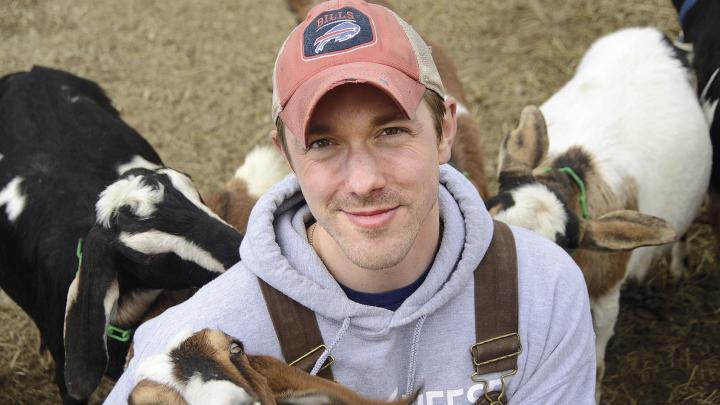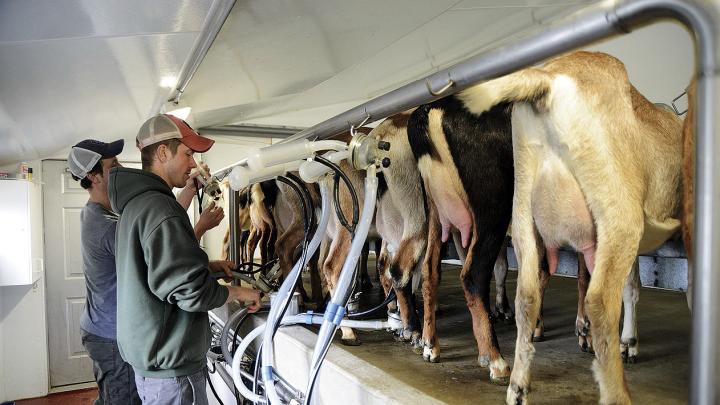For Max Sandvoss ’02 and his brother, Trystan, the chores associated with making small-batch artisanal cheese typically begin before dawn and, during western New York’s cold, snowy winters, end well after dark.
Their First Light Farm and Creamery in East Bethany, New York, a rural town midway between Rochester and Buffalo, is a long way from Hollywood, where Trystan was a producer and Max a film and television actor. The seed for their career change grew out of long conversations during an extended vacation in the Pacific Northwest. They fantasized about having a farm and living an agrarian lifestyle. Max began acting in college and found work (as Steve Sandvoss, his birth name) soon after arriving in Hollywood; he starred in Latter Days (2003) and appeared opposite Jennifer Aniston in Rumor Has It (2005). He says, “Some people work for years as bankers so they can afford to be painters. I’d made a little money and I thought, why should we wait until we retire to do the work we really want to do?” (To underline his new identity as a farmer, he changed his first name to Max.)
Now they look after a herd of more than 100 Nubian and Alpine goats. The goats’ milk, along with organic milk from a neighbor’s Jersey cows, underlies a variety of cheeses and other products the brothers sell in area farmers’ markets and upmarket grocery stores. Their wares, including three varieties of chèvre, cheddar, jack, feta, and cheddar curds, plus cream-top Jersey yogurt and bottled cream-top Jersey milk, are prized by local consumers and have recently become available through a weekly “dairy share” program. “I’m so much more fulfilled now,” Max says. “I think to myself, this is what job satisfaction is supposed to feel like.” (Web Extra: Watch a video featuring Max and Trystan Sandvoss.)
Producing their gourmet foods involves the relentless rhythm of farm work. Max and Trystan milk their goats twice daily, with occasional help from local students. (They aspire to afford full-time help someday.) They handle all the other tasks associated with their modern, artisanal version of the earliest type of food processing themselves, augmented with the latest technology: in the pasture or the creamery, they conduct business with tablets, smartphones, and Bluetooth headsets. Yet the goats must be milked on schedule, and the milk, by law, must be processed within 72 hours.
Although the brothers grew up in Westchester County, their New York State roots didn’t draw them to this fertile upstate farmland. The impetus came from their mother, Joyce, whose second husband (she was widowed when her sons were in high school) is a western New York dairy farmer. Max and Trystan apprenticed as cheesemakers in Washington State and originally intended to start a creamery there. But she persuaded them to buy an abandoned 20-acre horse farm near her husband’s 3,000-acre dairy operation. A year of arduous work transformed the equine facility into a small dairy farm.
The artisanal cheese that “foodies” treasure takes its particular qualities not only from the ruminants that produce the milk. “Making really fine cheese starts with the land,” Max says, gesturing to the pasture where the herd is nibbling. “The minerals and nutrients in the earth and the water that falls on it all affect the richness of the grass, which influences the milk and ultimately the quality of what we make from the milk.” Seasonal changes also affect the flavor of the cheese—their chèvre is milder in the spring and more full-bodied in the fall. Turning great milk into great cheese is “not hard, but it requires the right equipment, attention to detail, and intense focus on the process,” Max adds. “My brother likes to say that you can’t make good cheese with bad milk, but you can make bad cheese with good milk. We keep our goats healthy and make sure they have good grass, and they produce this amazing stuff. What we do after that honors the miraculous nature of the milk.”
“What’s the shelf life of milk?” asks Trystan, during a cheese-making workshop they offer at the farm. Trick question. “The shelf life is zero,” he says. “Nature intends milk to be consumed immediately.” He notes that milk goes directly from the mother to her offspring without even being exposed to air.
Bacteria turn milk into cheese, with specific bacterial cultures required for each type. The cheesemaker, Max says, provides the ideal set of conditions for the bacteria to do their work, including proper temperature, pH, salinity, and processing time. The entire process can be thrown off disastrously if the wrong bacteria or other microorganisms enter the mix. That sort of contamination is the bane of a cheesemaker’s life, and thus the Sandvosses are fanatics about cleanliness and accuracy. In some ways, their creamery resembles the clean rooms used to assemble satellites or electronic equipment, including a positive-pressure ventilation system designed to thwart airborne contaminants. The brothers change their boots when they enter the processing area, and change yet again when visiting nearby farms, all to minimize the chance of contamination.
Each of the First Light cheeses—based on goats’ milk, Jerseys’ milk, or blends of the two—has a recipe. Their chèvre is particularly admired; creamy in texture, its subtle combination of flavors stands apart from the almost astringent quality of mass-produced supermarket chèvre, which has turned off many potential customers. “First Light’s artisanal cheeses, including their chèvre, are very high quality,” says Andrew Galarneau, food writer for The Buffalo News. “They are well regarded by owners of specialty food stores, restaurant chefs, and consumers.” (Web Extra: Get a recipe for First Light Farm brownies.)
At First Light, making chèvre begins with a slow pasteurization that avoids the flavor damage caused by the high-temperature flash-pasteurization large dairies typically use. The brothers heat their milk to 140 degrees for 30 minutes, then cool it quickly to 70 degrees. Next they inoculate it with the appropriate bacterial culture, gently stirred through the vat.
After six hours they add rennet, which curdles the milk. Twenty-four hours later, the vat’s contents have become a gelatinous mass, to be ladled into gallon-sized muslin bags hung to drain for another 24 hours before being hand-packed into eight-ounce retail containers. (First Light trades the whey that drains off to a nearby farmer, to feed his pigs, swapping it for a share of his organic pork products. The Sandvosses work hard and eat well.)
They normally give their one-day cheese-making workshops twice a month, except during early-spring kidding season. The workshops focus on fresh cheeses that require little or no aging, such as mozzarella. (In contrast, First Light’s cheddar takes two years to mature.) Between the morning and afternoon sessions, attendees enjoy a lunch prepared by Joyce that features the farm’s products as ingredients in each course. Homemade brownies with a chèvre filling are far more delicious than one might imagine.










